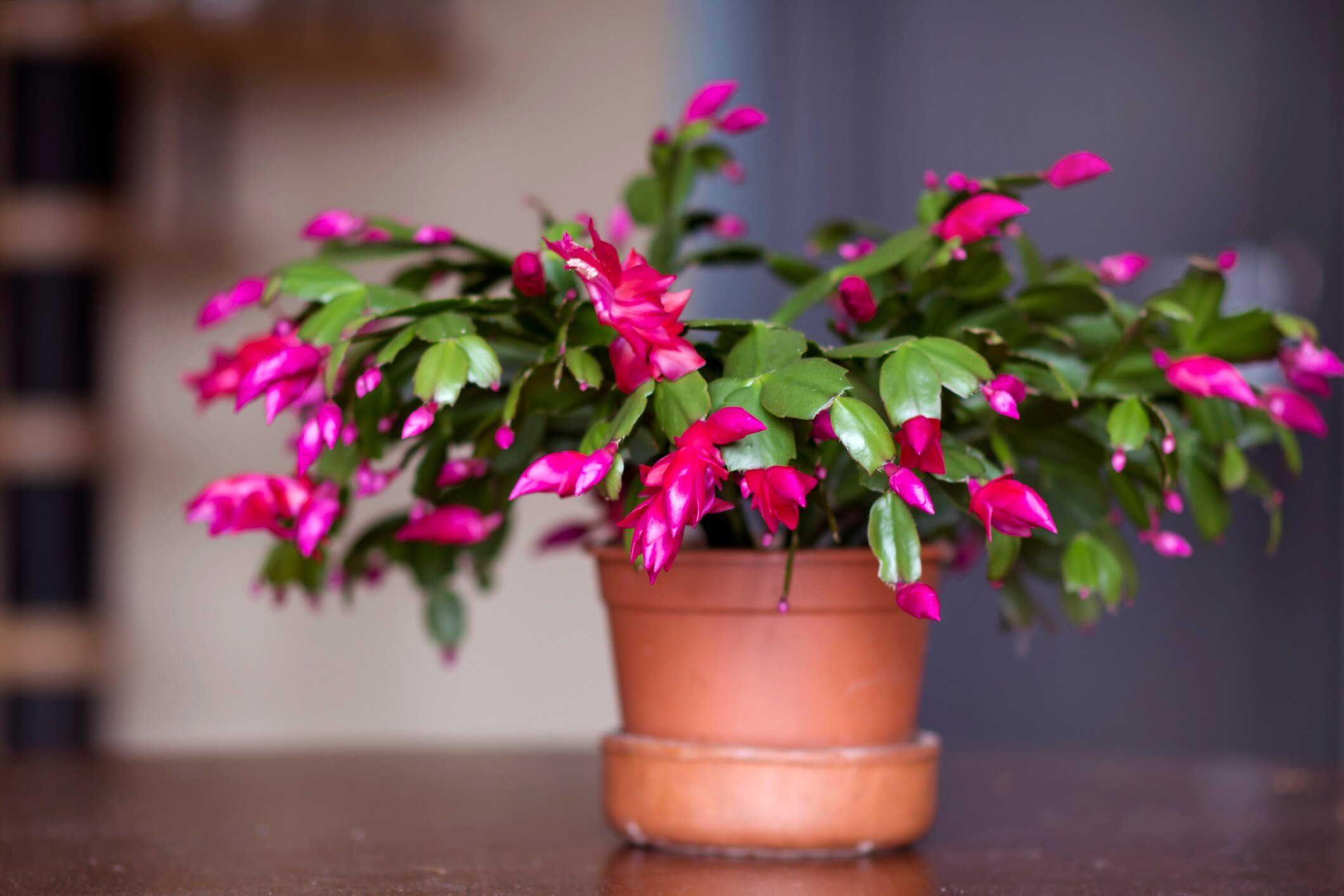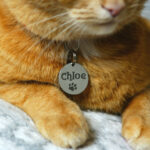The holiday season is a magical time, filling our homes with festive cheer and delightful decorations. Among the popular choices to bring the spirit of winter indoors is the beautiful Christmas cactus (Schlumbergera bridgesii). With its unique, segmented stems, eye-catching serrated edges, and vibrant blooms in a spectrum of colors like red, pink, orange, purple, and white, it’s no wonder this plant, which typically flowers around December, is a holiday favorite.
 A vibrant Christmas cactus potted plant displayed on a wooden table, showcasing its bright pink blooms and green segmented stems, in a well-lit home environment, emphasizing its decorative appeal and seasonal charm.
A vibrant Christmas cactus potted plant displayed on a wooden table, showcasing its bright pink blooms and green segmented stems, in a well-lit home environment, emphasizing its decorative appeal and seasonal charm.
These seasonal succulents, relatives of the Thanksgiving and Easter cacti, originate from the humid rainforests of Brazil. They flourish as houseplants, adding a touch of the tropics to our indoor spaces. While they bring joy to our homes, if you’re a cat owner, you might be wondering: Are Christmas Cactus Toxic To Cats? It’s a valid concern, especially if your curious feline has shown an interest in your festive flora. Let’s delve into the potential risks of Christmas cactus and cats living under the same roof.
Is Christmas Cactus Poisonous to Cats? Understanding the Risks
The good news for cat lovers is that Christmas cactus are generally considered to have low toxicity for cats. They are not listed as highly poisonous, but that doesn’t mean they are entirely risk-free. While a Christmas cactus won’t cause severe poisoning, it can still lead to digestive upset in your feline companion if ingested.
When a cat decides to nibble or chew on a Christmas cactus, the plant’s fibrous material can become an irritant. This irritation can affect your cat’s mouth, throat, and the sensitive lining of their stomach. As a result, you might observe symptoms like vomiting, diarrhea, a decrease in appetite, and lethargy. The intensity of these symptoms often depends on how much of the plant your cat has actually consumed.
If a significant portion of the Christmas cactus is eaten, there’s an increased risk of gastrointestinal blockage. This is a condition where the ingested plant material obstructs the stomach or intestines, preventing the normal passage of food and liquids. Vomiting is often an early indicator of a potential blockage as the body tries to expel the undigested plant matter.
Reassuringly, unlike desert cacti, the Christmas cactus is not a “true” cactus and thankfully lacks sharp spines. This eliminates the risk of physical injury from prickles if your cat brushes against or takes a small taste of the plant. The primary concern remains digestive irritation and potential blockage if larger quantities are ingested.
Symptoms of Christmas Cactus Ingestion in Cats: What to Watch For
If you suspect your cat has sampled your Christmas cactus, it’s crucial to monitor them for any signs of discomfort. Be vigilant for these symptoms which could indicate Christmas cactus poisoning in cats:
- Vomiting: This is a common reaction to stomach irritation or a possible blockage.
- Diarrhea: Indicates the plant is causing distress within the gastrointestinal tract.
- Lethargy: Unusual tiredness or lack of energy can signal your cat isn’t feeling well.
- Reduced Appetite: Discomfort in the stomach or mild nausea can lead to a decreased interest in food.
- Nausea: Subtle signs like excessive drooling or lip-smacking may suggest your cat is experiencing nausea.
These symptoms can manifest within a few hours after your cat has ingested part of the plant. If your cat has only taken a small bite, these signs might be mild and resolve on their own. However, if a larger amount was consumed, the symptoms could be more pronounced and indicate a more serious issue.
My Cat Ate Christmas Cactus: What Should I Do?
Discovering your cat has munched on your Christmas cactus can be concerning. The best course of action is to seek professional advice.
Immediately contact your veterinarian or the Pet Poison Helpline (1-855-764-7761), which is available 24/7 (note that a consultation fee may apply). These veterinary toxicology experts are equipped to assess the situation based on the amount of plant ingested and your cat’s symptoms.
Important: Never attempt to induce vomiting at home unless explicitly instructed by a veterinarian. Inducing vomiting inappropriately can lead to further complications.
If you are advised to monitor your cat at home, carefully observe them for any signs of gastrointestinal upset or potential obstruction. Pay close attention to vomiting, as this can be a key indicator of a blockage requiring immediate veterinary intervention.
Even if your cat appears fine initially, symptoms can develop later. Therefore, it’s vital to remain vigilant and closely monitor your cat for the duration advised by your vet or the Pet Poison Helpline.
What to Expect if Your Cat Eats Christmas Cactus: Treatment and Recovery
The veterinary guidance you receive will determine whether home monitoring is sufficient or if a vet visit is necessary. Minor ingestion might only require observation, while larger amounts or concerning symptoms will warrant veterinary care.
While Christmas cactus is low in toxicity for cats, ingestion can still lead to digestive issues.
For cases where a significant amount of Christmas cactus has been eaten, or if your cat is exhibiting troubling symptoms, a veterinarian can provide treatments to alleviate discomfort. These may include anti-nausea medications or intravenous fluids to combat dehydration if vomiting and diarrhea are severe.
In situations where a blockage is suspected, X-rays might be necessary to identify any obstructions caused by the plant material. Fortunately, with prompt veterinary care, the prognosis for cats who ingest Christmas cactus is generally good. Most cats recover fully without lasting effects. Some might need a few days of medication to settle their digestive system, but many return to their normal selves quickly.
Beyond Christmas Cactus: Other Holiday Plants Toxic to Cats
While Christmas cactus poses a relatively low risk, it’s essential to remember that many other popular holiday plants are significantly more dangerous for cats. Pet owners should exercise caution with these festive plants:
- Lilies: Extremely toxic to cats. Lily poisoning can cause severe kidney failure, with initial symptoms often including vomiting and lethargy.
- Christmas Trees: Oils from fir trees can cause drooling and digestive upset. Pine needles, if ingested, can lead to gastrointestinal obstructions.
- Mistletoe: Ingestion can result in drooling, vomiting, and diarrhea. Larger quantities can affect the cardiovascular and nervous systems.
- Holly: Small amounts can cause stomach upset, while larger ingestions can lead to significant digestive distress and, in rare cases, ataxia (wobbly gait).
- Amaryllis: This plant can cause vomiting, diarrhea, and abdominal pain. The bulb is particularly toxic and can lead to low blood pressure and seizures if consumed in large quantities.
- Poinsettia: Often overestimated in toxicity, poinsettias typically only cause mild stomach upset in cats.
Keeping Your Cat Safe This Holiday Season: Practical Tips
While the Christmas cactus presents a minimal hazard, many other holiday plants pose more serious threats to feline health.
To ensure your pet’s safety during the festive season, consider these preventative measures:
- Place Plants Out of Reach: Position holiday plants on high shelves, mantels, or hanging planters that are inaccessible to your cat.
- Opt for Pet-Friendly Decorations: Choose artificial plants or decorations that are non-toxic and pose no risk to your pets.
- Use Pet Gates: Employ pet gates to restrict access to rooms where potentially harmful plants are displayed.
If you are ever unsure about the safety of a particular plant, a quick call to your veterinarian or the Pet Poison Helpline can provide valuable guidance.
By being informed about potential plant hazards and remaining observant for any signs of ingestion, you can ensure a happy, healthy, and safe holiday season for both you and your beloved feline companion.
Pet Poison Helpline Veterinarian Team
Veterinarian
Pet Poison Helpline®, your trusted source for toxicology and pet health advice in times of potential emergency, is available 24 hours…

